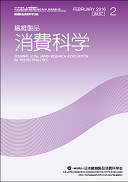
- |<
- <
- 1
- >
- >|
-
[in Japanese]2013Volume 54Issue 12 Pages 1030-1031
Published: December 20, 2013
Released on J-STAGE: September 14, 2017
JOURNAL RESTRICTED ACCESSDownload PDF (708K)
-
[in Japanese]2013Volume 54Issue 12 Pages 1032-1036
Published: December 20, 2013
Released on J-STAGE: September 14, 2017
JOURNAL RESTRICTED ACCESSDownload PDF (2033K)
-
[in Japanese]2013Volume 54Issue 12 Pages 1037-1041
Published: December 20, 2013
Released on J-STAGE: September 14, 2017
JOURNAL RESTRICTED ACCESSDownload PDF (1451K)
-
[in Japanese]2013Volume 54Issue 12 Pages 1042-1045
Published: December 20, 2013
Released on J-STAGE: September 14, 2017
JOURNAL RESTRICTED ACCESSDownload PDF (1572K)
-
[in Japanese]2013Volume 54Issue 12 Pages 1046-1049
Published: December 20, 2013
Released on J-STAGE: September 14, 2017
JOURNAL RESTRICTED ACCESSDownload PDF (1601K) -
[in Japanese]2013Volume 54Issue 12 Pages 1050-1052
Published: December 20, 2013
Released on J-STAGE: September 14, 2017
JOURNAL RESTRICTED ACCESSDownload PDF (2110K) -
[in Japanese]2013Volume 54Issue 12 Pages 1053-1055
Published: December 20, 2013
Released on J-STAGE: September 14, 2017
JOURNAL RESTRICTED ACCESSDownload PDF (986K) -
[in Japanese]2013Volume 54Issue 12 Pages 1056-1057
Published: December 20, 2013
Released on J-STAGE: September 14, 2017
JOURNAL RESTRICTED ACCESSDownload PDF (988K) -
[in Japanese]2013Volume 54Issue 12 Pages 1058-1060
Published: December 20, 2013
Released on J-STAGE: September 14, 2017
JOURNAL RESTRICTED ACCESSDownload PDF (1210K) -
[in Japanese]2013Volume 54Issue 12 Pages 1061-1063
Published: December 20, 2013
Released on J-STAGE: September 14, 2017
JOURNAL RESTRICTED ACCESSDownload PDF (1773K)
-
Toshiko AMEMIYA, Tadashi NAKANISHI2013Volume 54Issue 12 Pages 1064-1065
Published: December 20, 2013
Released on J-STAGE: September 14, 2017
JOURNAL OPEN ACCESSDownload PDF (780K)
-
Mamiko YATAGAI2013Volume 54Issue 12 Pages 1066-1074
Published: December 20, 2013
Released on J-STAGE: September 14, 2017
JOURNAL OPEN ACCESSClothing microclimate was compared by measuring temperature and humidity on the inside of brassiere (and breast form) on four female subjects who had undergone breast cancer surgery (mastectomy or lumpectomy). The temperature was higher at the diseased side than at the healthy side irrespective of the type of surgery. The humidity was higher at the diseased side in the post-mastectomy subjects, whereas, slightly lower at the diseased side in the post-lumpectomy subjects. Remarkably high temperature and humidity were observed on the inside of silicone breast form worn by the post-mastectomy subjects. Therefore, clothing microclimate was compared on three types of silicone breast forms with different material, structure and shape. The temperature and humidity measured on the inside of breast form were lower when wearing the improved products with built-in temperature equalizing layer and/or three dimensional surface on the back than when wearing the conventional product. The results indicate that improving breast forms could reduce thermal discomfort of the wearer.
View full abstractDownload PDF (2279K) -
Yuki KOHAMA2013Volume 54Issue 12 Pages 1075-1082
Published: December 20, 2013
Released on J-STAGE: September 14, 2017
JOURNAL OPEN ACCESSThe color of cloth, thread or Japanese paper which was dyed with natural dyes, natural pigments or synthetic dyes by the dyers or the tinters in Japan was measured using a spectrophotometric colorimeter. The color characteristic of natural dyes has been considered from the measured L*a*b* values (CIELAB). Natural dyes can develop the vivid yellow and the vivid red and the chroma of the turmeric, the pagoda tree, the amur corktree, the goldthread, the onion, the safflower, the cochineal and the lac was high specifically. On the one hand, natural dyes cannot develop vivid purple, vivid bluish green and dull green with the low brightness. The fiber which was dyed with natural inorganic pigments such as the ultramarine and the patina included the color which can't dye with the natural dyes. However, it was possible to distinguish from the dyestuff by the use of microscopic observation (×200). The color which can be dyed with natural dye and the color which can be dyed only with synthetic dye were made clear. The color which can't dye with natural colorant was in the cloth which showed a traditional color before the Edo period.
View full abstractDownload PDF (5435K)
-
[in Japanese]2013Volume 54Issue 12 Pages 1083
Published: December 20, 2013
Released on J-STAGE: September 14, 2017
JOURNAL RESTRICTED ACCESSDownload PDF (533K)
-
[in Japanese], [in Japanese]2013Volume 54Issue 12 Pages 1099-1100
Published: December 20, 2013
Released on J-STAGE: September 14, 2017
JOURNAL RESTRICTED ACCESSDownload PDF (969K) -
[in Japanese]2013Volume 54Issue 12 Pages 1101
Published: December 20, 2013
Released on J-STAGE: September 14, 2017
JOURNAL RESTRICTED ACCESSDownload PDF (620K)
-
[in Japanese]2013Volume 54Issue 12 Pages 1102
Published: December 20, 2013
Released on J-STAGE: September 14, 2017
JOURNAL RESTRICTED ACCESSDownload PDF (617K) -
[in Japanese]2013Volume 54Issue 12 Pages 1103
Published: December 20, 2013
Released on J-STAGE: September 14, 2017
JOURNAL RESTRICTED ACCESSDownload PDF (702K)
-
2013Volume 54Issue 12 Pages 1105
Published: December 20, 2013
Released on J-STAGE: September 14, 2017
JOURNAL RESTRICTED ACCESSDownload PDF (630K)
- |<
- <
- 1
- >
- >|